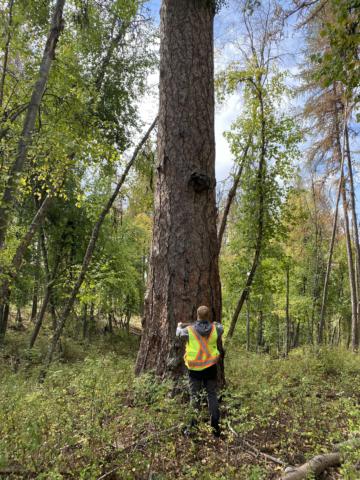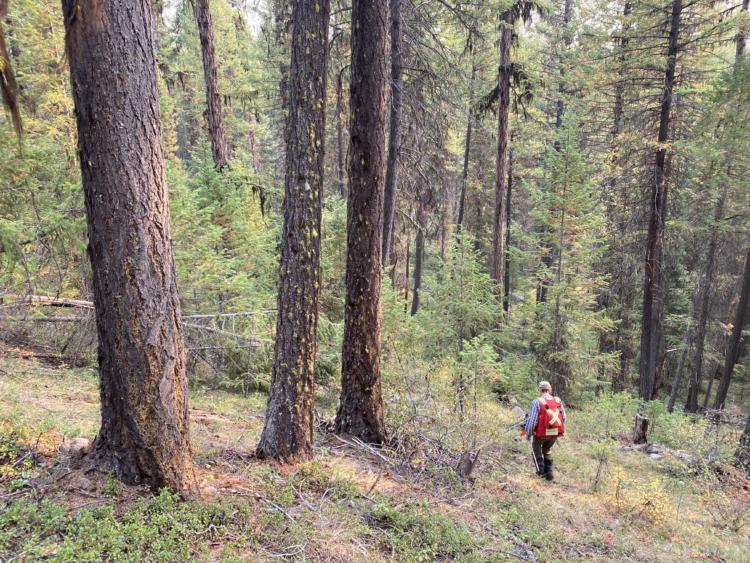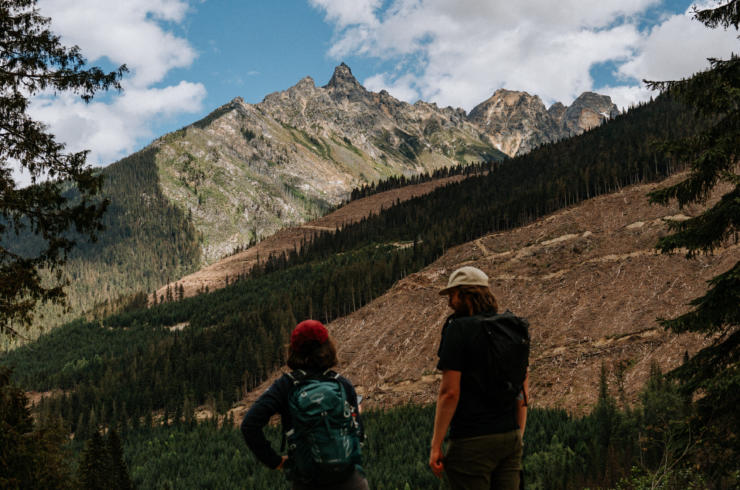Imagine flying nearly 4,000 kilometres from Mexico to sip the sap of BC’s old growth — only to arrive and find few ancient trees left.
Such is the life of a Williamson’s sapsucker, a little-known woodpecker that migrates every year from the southern US and Mexico to nest in the old growth western larch and ponderosa pines of our Okanagan highlands and East Kootenay.
Williamsons’s sapsuckers are a vital indicator species for old growth forest health because they need large trees that provide both cavities for nesting and large ant colonies for foraging.
“They need large, veteran trees that have survived many fires and are in the range of 300-600 years old. This is because they have heart-rots, and heart-rots are necessary for these birds to be able to excavate a nest,” says Les Gyug, a renowned biologist who has been studying these birds for decades.
Williamson’s sapsuckers use their long, brush-like tongues to lick any sap that oozes into the holes they drill in neat little lines into trees. A sapsucker will visit their personal sap wells multiple times a day. Adults feed on tree sap and phloem (the inner bark of a tree that transports nutrients), but when they have nestlings, the adults will switch to a high-protein diet of mostly ants to give their young the best chance at survival.
For many years, male and female Williamsons’s sapsuckers were thought to be two distinct species — because they look completely different. Although they technically don’t mate for life, many breeding pairs re-form regularly, year after year.

Losing their homes to the chainsaw
Williamson’s sapsuckers were listed as endangered in Canada in 2005, but despite a comprehensive federal recovery strategy, their critical habitat is still being logged.
Gyug says that in the Okanagan and Boundary areas about 50% of the land would have been high-quality habitat prior to the start of industrial logging. Now, because of logging, only about 2% of this area is still habitable for Williamson’s sapsuckers — and even that is now only low-to-moderate quality habitat. These sapsuckers are notoriously selective with their homes: if the forest is too sparse, they can’t move efficiently enough from tree to tree to gather enough ants for their nestlings, but if the forest is too dense, they don’t seem to be able to efficiently choose the tree trunks that actually have ants on them. What suitable habitat remains is now “a tiny, tiny area compared to what it was in the past. Almost every stand that was worth logging has been logged in the last century” says Gyug.
It doesn’t have to be this way. Selective logging that leaves a certain number of habitable trees for sapsuckers standing has been proven to be effective in maintaining Williamson’s sapsucker numbers. The best management practices drafted by the province recommend leaving at least seven suitable nest trees per hectare — typically the largest western larch, ponderosa pine, or sometimes Douglas fir trees in the area. Selective logging can also leave enough trees, about 100-200 per hectare, to allow the birds to forage on those tree trunks for the ants that make up 99% of what they feed their nestlings.

Starting in 2005, recovery talks progressed over the course of several years, and the forest licensee representatives at the table agreed to voluntarily abide by these best management recommendations. But not all forest licensees were on the same page.
In reality, only a fraction of the logging in critical Williamson sapsucker habitat has been done in a way that leaves enough trees for the birds to thrive. Although we shouldn’t be logging any more old growth in BC at all, at a bare minimum, selective harvesting to protect these endangered birds should be mandatory. In 2021, the federal government even granted the TMX pipeline a permit to clearcut through 10.8 kilometres of critical Williamsons’s sapsucker habitat.
These are prime examples of why we need the provincial government to legislate protection of species and ecosystems. Gentle suggestions simply aren’t good enough, and only encourage industries to continually cut corners at the expense of our precious biodiversity.
“They generally log about 1 percent of habitat per year. So let’s say 1/3 of the forest is being logged in a Williamson-sapsucker-friendly manner. Then we’re losing 2/3 of a percent of their habitat per year. You can only keep doing that for so long, and then you get a threshold effect where it looks like they’re doing really good now, but all of a sudden the bottom falls out.” Gyug warns that even if these numbers don’t seem critical yet, the tipping point could be imminent. “There tend to be threshold effects in biology where the animals can keep going for quite a while as you hack away at their habitat, but it reaches a point where they can’t take it anymore and then they just can’t reproduce.” And once that happens, there’s no going back.

When recovery strategies for species at risk are presented, the federal government is supposed to create an action plan that details exactly how the strategy will be carried out. However, no action plan for Williamson’s sapsuckers was ever prepared. With less than 1,000 breeding individuals left in BC and zero regulation to protect the species, we need concrete legislation to protect these birds.
Part of the core issue is that the federal Species at Risk Act is almost never used directly to protect those species outside of federal lands. Elsewhere, BC calls the shots — and the reality is that industry profit is still dictating how those shots are being called. As logging in BC is regulated by the province, what we really need is comprehensive provincial legislation that protects species at risk and biodiversity. This would ensure that industry plans respect the habitat needs of endangered species like the Williamson’s sapsucker — and protect the broader ecosystems that they rely on.
In 2017, the BC NDP campaigned on a promise to enact species at risk legislation, but have yet to introduce it. The lack of legislation to protect our species will have dire consequences, Gyug warns. “We can’t just keep cutting everything down for our use and saying, ‘Oh, we’re having no impact’ because we’re having huge impacts.”
Earlier this year, BC removed the “unduly” clause from the Forest Range and Practices Act which prevented protection of ecosystems and wildlife that would unduly reduce timber supply. That means forest planners should now be able to decide to prioritize species like sapsuckers above logging profits.
On this, Gyug concludes: “Just because that’s been removed doesn’t mean it’s been removed in the minds of the politicians and bureaucrats that make up the Forest Service or anything else. We need to realize that the job of the Forest Service is not to fill up the mills or to fill up the coffers of British Columbia, it is also to create habitat for the species out there. And not just the rare ones and endangered ones, but the common ones too, which are only common because we can have habitat for them.”

Speak up for old growth








